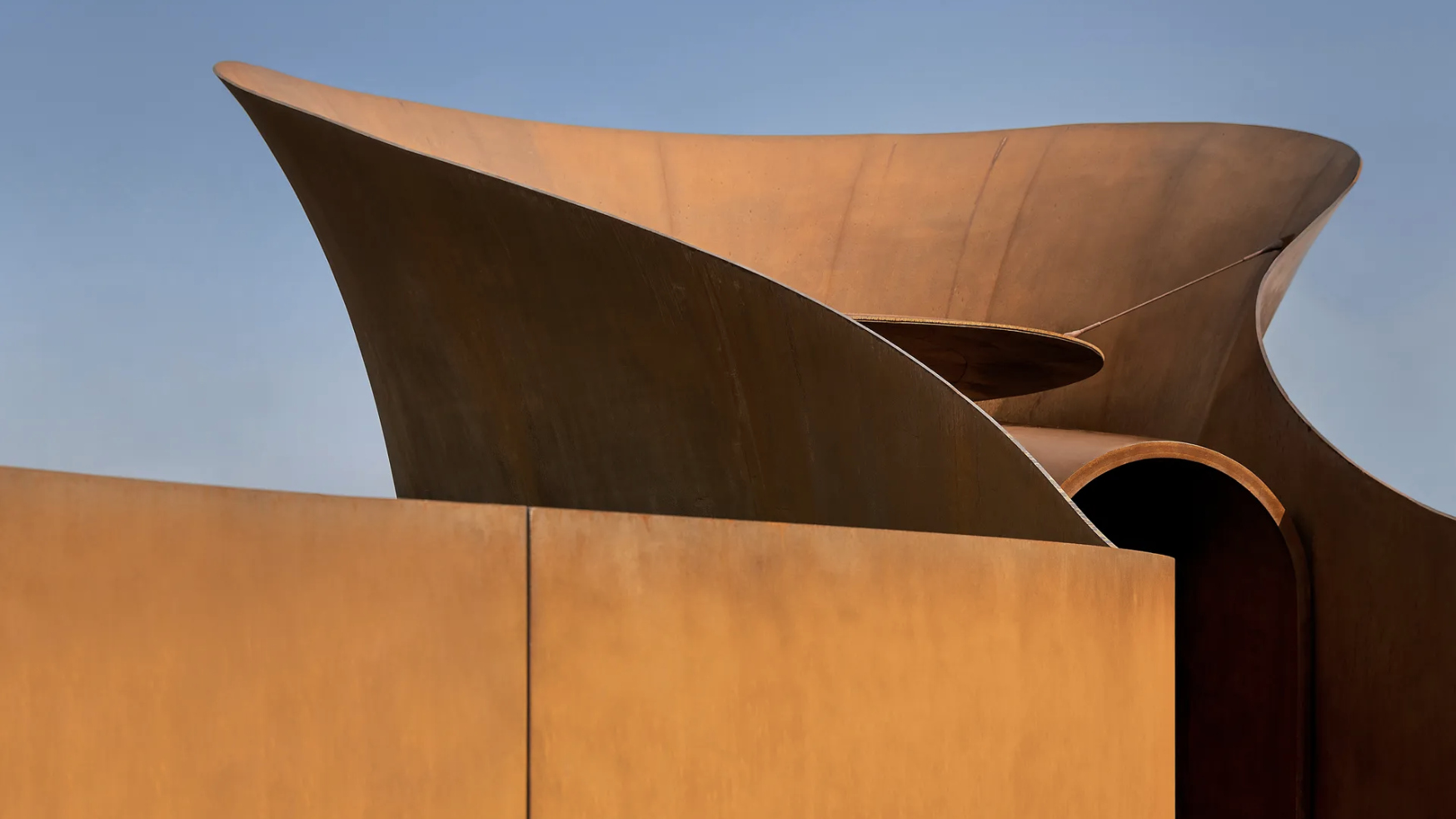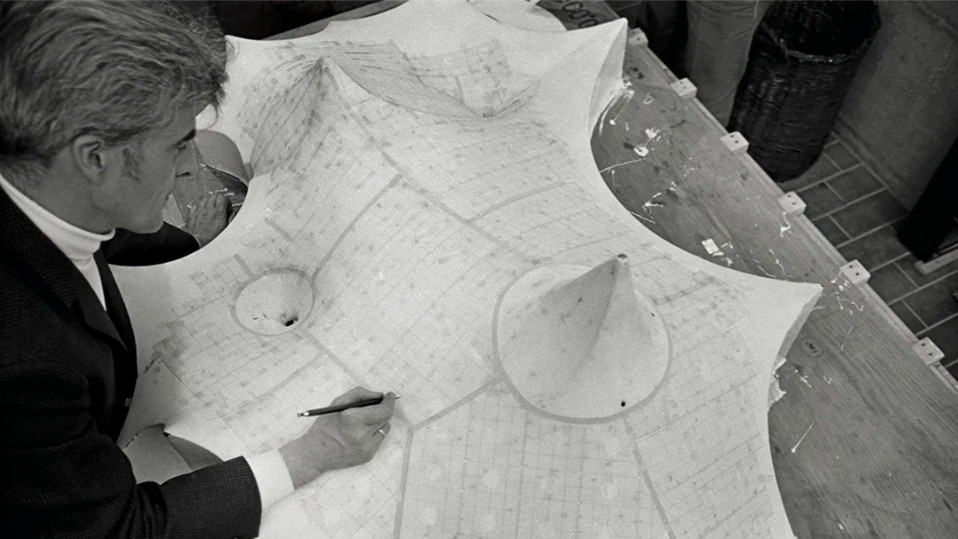Berlin's Atelier Gardens gets bright yellow focal point within MVRDV masterplan
The bright yellow HAUS 1 becomes a key addition to Atelier Gardens in Berlin, part of an ever-evolving, sustainable masterplan by MVRDV

Atelier Gardens, a six-acre creative film and community impact campus in Berlin, has welcomed the opening of the bright yellow ‘Haus 1’, an inventively and sustainably refurbished 1990s office building. Haus 1 is a new central hub for the campus, and was an important site for German film, TV and even propaganda since the early 20th century, located just south of Tempelhof Field.
The five-storey building hosts a concierge, a cafe, office space, and a daylight-filled rooftop events venue with skyline views. It also features a dynamic 57m-long yellow ‘stair-scape’ that channels rainwater for re-use in the gardens and toilets – vital functions that are all strategic to growing the environmentally and socially sustainable campus vision of London-based developer and operator Fabrix, which took stewardship in 2020.

HAUS 1: a key part of MVRDV's Atelier Gardens masterplan
The adaptive re-use and eco-friendly interior design of the building is part of Dutch architects MVRDV’s masterplan to transform the previously tired industrial site into a playful, colourful village that champions circularity by design. MVRDV architect Klaas Hofman saw a lot of potential in the group of 'introvert' yet 'diverse' buildings, ranging from a 1934 heritage-protected studio warehouse to boxy late 20th century office blocks. Despite varying quality, they vowed to demolish nothing, instead creating community and identity through renovations, landscaping, bold colours and way-finding.
Today, a cross-disciplinary community buzzes between the five film studios, 11 dubbing studios and 140 workspaces. It’s not uncommon to see Brad Pitt or Taika Waititi grabbing a coffee and sets being built for Amazon or Netflix. Yet alongside this quite transient activity, you’ll find social and environmental activists turning up for work everyday; such as Extinction Rebellion and Greta Thunberg’s Fridays for Future amongst others. Haus 1 is a key anchor for this latter activity, now offering larger workspaces with newly opened up floor plans, bio-based insulation, solar shading and the CLT rooftop extension, all led together with local architects Hirschmüller Schindele Architekten.

Across the campus, landscape design by London-based Harris Bugg Studio supports Atelier Gardens’ circular vision. Waste concrete from the building was re-used or crushed into a soil aggregate for water retention, weed suppression and improved habitat diversity – all resulting in 300 tonnes of material prevented from landfill to date, and more to come.
It’s very much a 'working site' says landscape designer Charlotte Harris, who has begun a 'radical re-greening' with tough pioneering and nitrogen-fixing plants. She started with six trees, now there are 57, with a total of 180 planned. It’s her long-term goal to eventually forge a green corridor with Tempelhof Field; all while improving soil health with composting initiatives run by the zero-waste restaurant Roots Radical; and creating hospitable natural spaces for wellbeing.

At MVRDV, Hofman has been working on adaptive re-use for decades since he joined in 2008, and has recognised a shift in how people receive it, specially with former industrial buildings. 'Today people really appreciate open-ended industrial spaces, yet it’s important to bring an identity to them.'
Receive our daily digest of inspiration, escapism and design stories from around the world direct to your inbox.
Colour, he explains, is a key tool: 'By using bright colours we can bring industrial buildings into the foreground, instead of making them disappear. It’s much more interesting and we can celebrate the building once again.' He also wrapped a colourful (this time, red) staircase around the MVRDV-designed, new yet industrially-inspired and fully demountable Portlantis Harbour Experience Centre in Rotterdam (opening 2024).

Atelier Gardens will continue to unfold without a specified end point. 'It’s an evolving masterplan guided by the principles of sustainability and re-use,' says Hofman. 'Each mile stone is a stepping stone, attracting different users, with the landscape forming around it into a natural environment.'
While Haus 1 plays a key part in bringing more businesses to the campus, its bright yellow colour and dynamic ‘stair-scape’ importantly marks Atelier Gardens as a place of optimism: 'It’s a colour that says “there’s something happening here!” and that all urban buildings have potential,' says Hofman.

Harriet Thorpe is a writer, journalist and editor covering architecture, design and culture, with particular interest in sustainability, 20th-century architecture and community. After studying History of Art at the School of Oriental and African Studies (SOAS) and Journalism at City University in London, she developed her interest in architecture working at Wallpaper* magazine and today contributes to Wallpaper*, The World of Interiors and Icon magazine, amongst other titles. She is author of The Sustainable City (2022, Hoxton Mini Press), a book about sustainable architecture in London, and the Modern Cambridge Map (2023, Blue Crow Media), a map of 20th-century architecture in Cambridge, the city where she grew up.
-
 Togo's Palais de Lomé stages a sweeping new survey of West African design
Togo's Palais de Lomé stages a sweeping new survey of West African design'Design in West Africa' in Lomé, Togo (on view until 15 March 2026), brings together contemporary designers and artisans whose work bridges tradition and experimentation
-
 Vigilante’s 1979 Jeep Wagoneer features luxury trim, modern muscle and elevated styling
Vigilante’s 1979 Jeep Wagoneer features luxury trim, modern muscle and elevated stylingTexan restomod master Vigilante has created a new take on the classic Jeep Wagoneer, transforming the 1970s family SUV into a sleek, architectural powerhouse
-
 Australian studio Cordon Salon takes an anthropological approach to design
Australian studio Cordon Salon takes an anthropological approach to designWallpaper* Future Icons: hailing from Australia, Cordon Salon is a studio that doesn't fit in a tight definition, working across genres, techniques and materials while exploring the possible futures of craft
-
 Doshi Retreat at the Vitra Campus is both a ‘first’ and a ‘last’ for the great Balkrishna Doshi
Doshi Retreat at the Vitra Campus is both a ‘first’ and a ‘last’ for the great Balkrishna DoshiDoshi Retreat opens at the Vitra campus, honouring the Indian modernist’s enduring legacy and joining the Swiss design company’s existing, fascinating collection of pavilions, displays and gardens
-
 A new book delves into Frei Otto’s obsession with creating ultra-light architecture
A new book delves into Frei Otto’s obsession with creating ultra-light architecture‘Frei Otto: Building with Nature’ traces the life and work of the German architect and engineer, a pioneer of high-tech design and organic structures
-
 What is Bauhaus? The 20th-century movement that defined what modern should look like
What is Bauhaus? The 20th-century movement that defined what modern should look likeWe explore Bauhaus and the 20th century architecture movement's strands, influence and different design expressions; welcome to our ultimate guide in honour of the genre's 100th anniversary this year
-
 Step inside Clockwise Bremen, a new co-working space in Germany that ripples with geological nods
Step inside Clockwise Bremen, a new co-working space in Germany that ripples with geological nodsClockwise Bremen, a new co-working space by London studio SODA in north-west Germany, is inspired by the region’s sand dunes
-
 Portlantis is a new Rotterdam visitor centre connecting guests with its rich maritime spirit
Portlantis is a new Rotterdam visitor centre connecting guests with its rich maritime spiritRotterdam visitor centre Portlantis is an immersive experience exploring the rich history of Europe’s largest port; we preview what the building has to offer and the story behind its playfully stacked design
-
 Join our world tour of contemporary homes across five continents
Join our world tour of contemporary homes across five continentsWe take a world tour of contemporary homes, exploring case studies of how we live; we make five stops across five continents
-
 A weird and wonderful timber dwelling in Germany challenges the norm
A weird and wonderful timber dwelling in Germany challenges the normHaus Anton II by Manfred Lux and Antxon Cánovas is a radical timber dwelling in Germany, putting wood architecture and DIY construction at its heart
-
 A Munich villa blurs the lines between architecture, art and nature
A Munich villa blurs the lines between architecture, art and natureManuel Herz’s boundary-dissolving Munich villa blurs the lines between architecture, art and nature while challenging its very typology